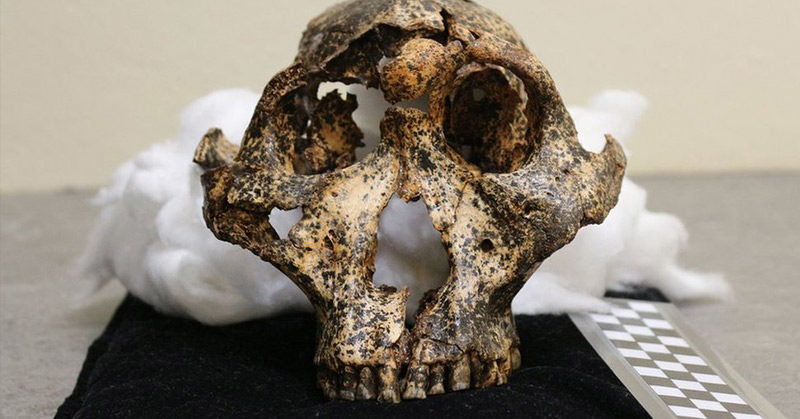Researchers in Australia recently discovered a 2 million-year-old skull that gives us more clues about our evolution as a species. The skull, which they found in South Africa, is of the species Paranthropus robustus, a cousin species to our predecessors, Homo erectus. Many recent fossil discoveries, like the Siberian Unicorn or the “dinosaur mummy” have given us glimpses of the past. This skull, however, is teaching us more about our own history as a species.
A Brief History of Human Evolution

Today’s modern humans (aka- us) are of the species Homo sapiens. According to the Smithsonian, Homo sapiens evolved in Africa approximately three hundred thousand years ago. As modern humans, we are characterized by the lighter build of our skeletons, very large brains, smaller jaws, and much smaller teeth.
Scientists still have many questions about how our species came to be. These include questions like:
- Who was our direct evolutionary ancestor?
- How much interbreeding occurred between Homo sapiens and other species?
- What does the future of evolution look like for modern humans? [1]
This 2 million-year-old skull is helping scientists get closer to answering some of the questions.

One species that scientists believe is a direct ancestor of modern humans is the Homo erectus. These were the first of our relatives to have more human-like body proportions, such as shorter arms and longer legs. Experts also believe this was the first species of hominids to migrate out of Africa, and possibly the first to cook food. We have fossil evidence of Homo erectus that spans over 1.5 million years. This makes it the longest-surviving of all our relatives by a wide margin. While most scientists agree that Homo erectus is one of our direct ancestors, not all of them agree on exactly how we relate to each other [2].
Paranthropus robustus

This 2 million-year-old skull, however, is of a different species of hominid. Scientists believe it is of the species Paranthropus robustus, which is a “cousin species” to Homo erectus. The two species lived around the same time, but P. robustus died out earlier [3]. Members of the P. robustus species looked very different from H. erectus, and diverged even more from modern humans. They had very large teeth with thick enamel, large cheekbones, and large jaws.
This gave them a very wide, dish-shaped face.

The purpose of the characteristics was to give them the ability to chew very tough, fibrous foods. The “robust” and sizable nature of their jaws, however, did not translate into the rest of their bodies. P robustus were much smaller than modern humans, and the average male was just under four feet tall and weighed 119 pounds. The average female was barely over three feet tall and weighed less than 90 pounds [4].
Read: Girl, 8, pulls a 1,500-year-old sword from a lake in Sweden
The 2 Million-Year-Old Skull

Researchers from La Trobe University in Melbourne discovered the fragments of this ancient skull in 2018. They found it mere meters away from a spot where scientists uncovered a Homo erectus skull of a child in 2015. The two skulls appeared to be close in age. The research team is very excited about this finding. “Most of the fossil record is just a single tooth here and there so to have something like this is very rare, very lucky,” explained Dr Angeline Leece [3]. The team has spent the last two years piecing the fossil together and analyzing it. Jesse Martin, one of the team’s researchers, described handling the fossil as “working with wet cardboard”. He had to use plastic straws to suck the last of the dirt off of them.
Microevolution

This 2 million-year-old skull is an example of microevolution within the human lineage. In fact, scientists now believe that at one point in history, there were actually three hominins living in South Africa. These include P. robustus, H. erectus, and another species, Homo heidelbergensis. Experts think that the latter was a common ancestor of both modern humans and Neanderthals [5].
Skull Differences

The differences between the skulls of the three hominins provide evidence to explain how early species of humans adapted and evolved. “Through time, Paranthropus robustus likely evolved to generate and withstand higher forces produced during biting and chewing food that was hard or mechanically challenging to process with their jaws and teeth,” said Dr Leece [3]. Homo erectus, however, had smaller teeth, which indicates that they likely ate both plants and meat. Scientists believe that climate change created a wetter environment likely reducing the food that was available to P. robustus, which is why they eventually died out. “These two vastly different species… represent divergent evolutionary experiments,“ Dr Leece said [3].
Many Unanswered Questions

This 2 million-year-old skull has given scientists many insights into the evolutionary past of modern humans. Still, there are many questions that remain unanswered. What species did P. robustus evolve from? Which species is our direct ancestor? By studying the fossils, genetics, behavior, and biology of modern humans, scientists are trying to answer these questions. Every discovery like this puts them one step closer to uncovering our ancient past. To learn more, you can read the researchers’ paper, which they published in the Nature, Ecology, and Evolution journal.
Keep Reading: Mysterious radio signal is coming from inside our galaxy, scientists announce
Sources
- https://humanorigins.si.edu/evidence/human-fossils/species/homo-sapiens
- https://www.nhm.ac.uk/discover/homo-erectus-our-ancient-ancestor.html
- https://www.bbc.com/news/world-australia-54882214
- https://humanorigins.si.edu/evidence/human-fossils/species/paranthropus-robustus
- https://www.bbc.com/news/science-environment-52133534

